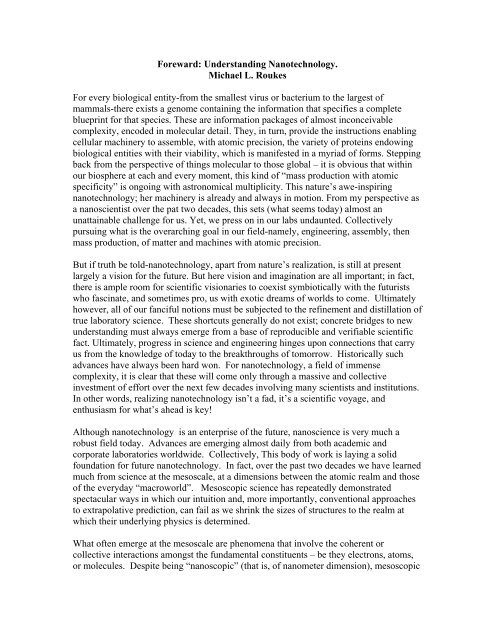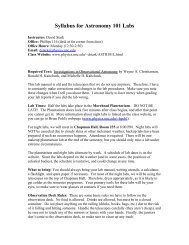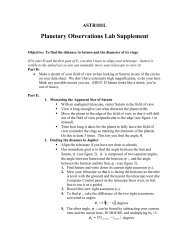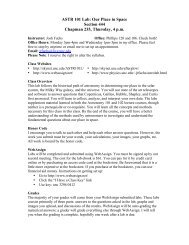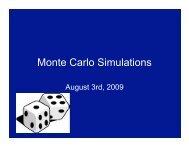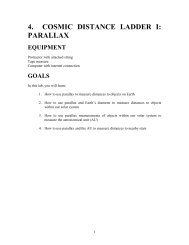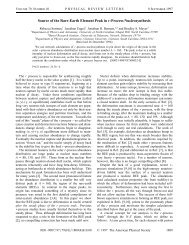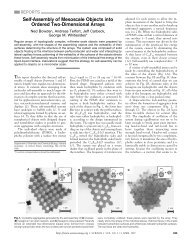Foreward: Understanding Nanotechnology. Michael L. Roukes For ...
Foreward: Understanding Nanotechnology. Michael L. Roukes For ...
Foreward: Understanding Nanotechnology. Michael L. Roukes For ...
Create successful ePaper yourself
Turn your PDF publications into a flip-book with our unique Google optimized e-Paper software.
<strong><strong>For</strong>eward</strong>: <strong>Understanding</strong> <strong>Nanotechnology</strong>.<br />
<strong>Michael</strong> L. <strong>Roukes</strong><br />
<strong>For</strong> every biological entity-from the smallest virus or bacterium to the largest of<br />
mammals-there exists a genome containing the information that specifies a complete<br />
blueprint for that species. These are information packages of almost inconceivable<br />
complexity, encoded in molecular detail. They, in turn, provide the instructions enabling<br />
cellular machinery to assemble, with atomic precision, the variety of proteins endowing<br />
biological entities with their viability, which is manifested in a myriad of forms. Stepping<br />
back from the perspective of things molecular to those global – it is obvious that within<br />
our biosphere at each and every moment, this kind of “mass production with atomic<br />
specificity” is ongoing with astronomical multiplicity. This nature’s awe-inspiring<br />
nanotechnology; her machinery is already and always in motion. From my perspective as<br />
a nanoscientist over the pat two decades, this sets (what seems today) almost an<br />
unattainable challenge for us. Yet, we press on in our labs undaunted. Collectively<br />
pursuing what is the overarching goal in our field-namely, engineering, assembly, then<br />
mass production, of matter and machines with atomic precision.<br />
But if truth be told-nanotechnology, apart from nature’s realization, is still at present<br />
largely a vision for the future. But here vision and imagination are all important; in fact,<br />
there is ample room for scientific visionaries to coexist symbiotically with the futurists<br />
who fascinate, and sometimes pro, us with exotic dreams of worlds to come. Ultimately<br />
however, all of our fanciful notions must be subjected to the refinement and distillation of<br />
true laboratory science. These shortcuts generally do not exist; concrete bridges to new<br />
understanding must always emerge from a base of reproducible and verifiable scientific<br />
fact. Ultimately, progress in science and engineering hinges upon connections that carry<br />
us from the knowledge of today to the breakthroughs of tomorrow. Historically such<br />
advances have always been hard won. <strong>For</strong> nanotechnology, a field of immense<br />
complexity, it is clear that these will come only through a massive and collective<br />
investment of effort over the next few decades involving many scientists and institutions.<br />
In other words, realizing nanotechnology isn’t a fad, it’s a scientific voyage, and<br />
enthusiasm for what’s ahead is key!<br />
Although nanotechnology is an enterprise of the future, nanoscience is very much a<br />
robust field today. Advances are emerging almost daily from both academic and<br />
corporate laboratories worldwide. Collectively, This body of work is laying a solid<br />
foundation for future nanotechnology. In fact, over the past two decades we have learned<br />
much from science at the mesoscale, at a dimensions between the atomic realm and those<br />
of the everyday “macroworld”. Mesoscopic science has repeatedly demonstrated<br />
spectacular ways in which our intuition and, more importantly, conventional approaches<br />
to extrapolative prediction, can fail as we shrink the sizes of structures to the realm at<br />
which their underlying physics is determined.<br />
What often emerge at the mesoscale are phenomena that involve the coherent or<br />
collective interactions amongst the fundamental constituents – be they electrons, atoms,<br />
or molecules. Despite being “nanoscopic” (that is, of nanometer dimension), mesoscopic
structures that are too large, in general, to allow easy theoretical modeling using<br />
conventional approaches of quantum physics or chemistry. So this is indeed a tricky<br />
realm, where unexpected and wonderful new properties emerge – and the elucidation of<br />
such properties represent the “front lines” of some of today’s most exciting nanoscience.<br />
Nobel laureate and Caltech physics professor Richard P. Feynman clearly anticipated<br />
these forefronts in 1959, in his legendary speech “Plenty of Room at the Bottom” [1].<br />
“This field is not quite the same as the others in that it will not tell us much of the<br />
fundamental physics in the sense of, ‘What are the strange particles?’. But it is more like<br />
solid state physics in the sense that it might tell us much of the great interest about the<br />
strange phenomena that occur in complex situations. Furthermore, a point that is most<br />
important is that it would have an enormous number of technical applications.”<br />
It is precisely upon such complex systems that nanotechnology will be built - nanoscale<br />
systems that are too large to be considered molecules, but not yet large enough to<br />
transcend the seemingly exotic mesoscopic world back to the ordinary realm of the<br />
macroscopic. In 1972, another Nobel physicist, Phillip W. Anderson, elegantly<br />
articulated the concept of “emergent” properties in complex systems in his seminal article<br />
entitled “More is different” [2].<br />
“The behavior of large and complex aggregations of elementary particles, it turns out, is<br />
not to be understood in terms of a simple extrapolation of the properties of a few<br />
particles. Instead, at each level of complexity entirely new properties appear, and the<br />
understanding of the new behaviors requires research which I think is as fundamental in<br />
nature as any other”<br />
So as we survey the impressive recent advances of naonscience (such as outlined in this<br />
volume) it begins to become clear that much, if not most, still remains to be learned.<br />
From this knowledge will emerge the rules that future nanoengineers will routinely<br />
employ to realize their atomically precise technology. Meanwhile, our research today on<br />
systems at the nanoscale is a crucible within which traditionally disparate disciplines –<br />
from the life sciences, to quantum physics, to semiconductor device engineering – are<br />
melding to form a new science. At this exciting convergence of fields we are<br />
collaboratively beginning to teach ourselves new ways to thing about – and to engineer –<br />
matter at ultrasmall dimensions.<br />
[1] A transcript is available at www.its.caltech.edu/~feynman<br />
[2] P. W. Anderson, Science 177, 393 (1972).


